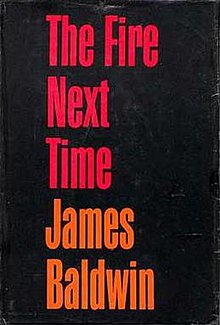The Fire Next Time

First edition cover
|
|
| Author | James Baldwin |
|---|---|
| Country | United States |
| Language | English |
| Genre | Essays |
| Publisher | Dial Press |
|
Publication date
|
1963 |
| Pages | 128 |
The Fire Next Time is a 1963 book by James Baldwin. It contains two essays: "My Dungeon Shook — Letter to my Nephew on the One Hundredth Anniversary of Emancipation," and "Down At The Cross — Letter from a Region of My Mind." The first essay, written in the form of a letter to Baldwin's 14-year-old nephew, discusses the central role of race in American history. The second essay deals with the relations between race and religion, focusing in particular on Baldwin's experiences with the Christian church as a youth, as well as the Islamic ideas of others in Harlem.
The book was first published by The New Yorker and owing to its great success, it was subsequently published in book form by Dial Press in 1963, and in Britain by Penguin Books in 1964; both essays in the book had previously been published in The Progressive and The New Yorker, respectively. Critics greeted the book enthusiastically; it is considered, by some, one of the most influential books about race relations in the 1960s. It was released in an audiobook format in 2008 and narrated by Jesse L. Martin.
The book's title comes from the couplet "God gave Noah the rainbow sign / No more water but fire next time" in Mary Don't You Weep, a Negro spiritual.
This book consists of two essays, both examining the problems blacks faced in America in the early 1960s. Themes other than "the Negro Problem" explored by the book include an examination of the shallowness and ineffectiveness of religious faith and of intergenerational influences and relationships.
The two essays in this book make up what is essentially a three-point dissection of "The Negro Problem" (a euphemism for racial tension) in the America of the early 1960s. The first of these three points is a personal perspective on the experience of being a Negro in America at that time and is developed in both essays: throughout the entirety of the first, and in the extended middle section of the second. In both pieces of writing, the author speaks eloquently, at times with anger and at other times with an almost desperate compassion, of how it feels to live the life of a Negro, with all the racist connotations of that word intact.
...
Wikipedia
